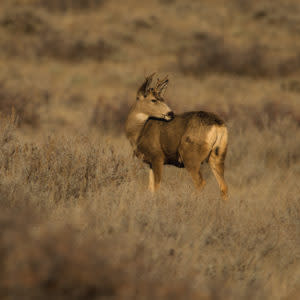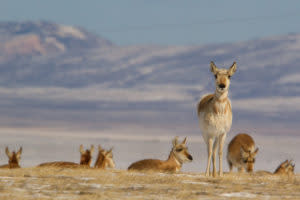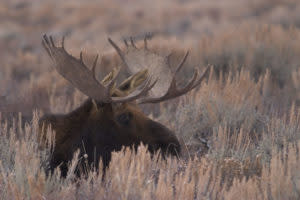It’s that time of year again! Time to plan a Wyoming hunting trip and apply for Wyoming hunting tags. Many hunters struggle with where to begin when applying for Wyoming big game hunting licenses. It can be daunting to navigate the regulations, preference points, and application process, especially for out-of-state hunters. However, Wyoming's outstanding hunting experiences make it well worth the undertaking.
Things to Consider When Applying for Wyoming Big Game Hunting Licenses

Pronghorn Antelope (photo courtesy of Wyoming Game and Fish)
Hunters should take into account several important considerations when planning a Wyoming hunt and applying for Wyoming hunting licenses. Not all hunts are created equal in terms of cost, time-investment, physical requirements, and odds of success. Hunter should decide whether to pursue a once-in-a-lifetime trophy hunt or a more laid-back experience.
Hunters must also decide if they want or need to hire a licensed outfitter? Guides and outfitters provide expertise that is invaluable when hunting--especially when pursuing a trophy. They may also provide resources, equipment, and even access to areas that might otherwise be hard to come by.
Utilizing the Wyoming Hunt Planner or downloading the Application Booklet is the best place to start. For a detailed explanation of the entire application process visit the Wyoming Game and Fish Application Process page.
Cost of License for Different Big Game Species

Laramie Peak Mule Deer (photo courtesy of Wyoming Game and Fish)
Species preference is the most obvious factor when deciding what type of Wyoming hunting license to apply for. Hunters should also consider the cost of a tag. There is a massive difference in the prices of each tag. For example, a non-resident bison can be as much as $4,402, whereas a non-resident doe/ fawn antelope is only $34. See a complete list of license fees here.
Additional Costs
Besides the price of the tag, hunters should consider the cost of gear they may need to supply, as well as transportation, accommodations, and whether or not you need to hire an outfitter. Also, a successful hunt leads to additional costs like meat processing, shipping, and taxidermy.
Other Requirements
There is also a difference in the time investment and physical demands of hunting various species. For example, hunting a moose requires a great deal of time spent pursuing elusive creatures over difficult terrain. Should you be fortunate enough to draw a rare moose tag, you will not want your hunt limited by your ability to invest time and energy in a successful hunt. These factors are also significantly impacted by whether or not you hire an outfitter.
Wyoming Big Game Hunting License Draw Odds
Of course, draw odds are also an important factor to consider. For example, you are far less likely to draw a bison, moose, or bighorn sheep tag than an antelope or deer tag. Your draw odds for a specific species are also impacted by the hunting “area” you choose. If you simply want to enjoy a Wyoming hunt, putting in for a deer or antelope tag is a much safer bet.
It is also important to note that in addition to General Hunting Regulations, different species are subject to different seasons and different regulations. See a complete listing of Wyoming Game and Fish Regulations here.

Young Hunter (photo courtesy of Wyoming Game and Fish)
Hunting Area
After choosing which species to pursue, hunters must choose which area to hunt in. “Area” refers to the designated area or areas of land you are allowed to hunt on. There are areas which are limited quota, as well as general areas for deer and elk.
This is also species-dependent. Bison, bighorn sheep, mountain goats, and antelope are all limited quota only tags. For these tags, hunters must choose and rank up to three specific areas. Deer tags and elk tags can be either limited quota or general. However, non-resident hunters must still be selected (drawn) and are not guaranteed a general tag. For general deer tags, hunters must choose a region and are then eligible to hunt all the general areas within that region if you are selected. Hunters who draw a general elk tag may hunt any of the general elk areas.
Area Draw Odds
There are several points for hunters to consider when choosing which area or region to apply for. Individual areas have different draw odds and odds of success. Hunters should review the Draw Odds and Harvest Report for each area.
Access
The amount of public land available to hunt, and the ease of access to the public lands, also affect hunting areas and regions. Hunters are not permitted on private land except with permission, or under special circumstances. This includes both hunting and crossing private land in order to access public land. Public access ratings are also available for each area as denoted by an asterisk.
Wilderness Areas and Wildlife Habitat Management Areas
Besides private land, some hunting areas contain other land designations that may be subject to special conditions and regulations. For example, some areas also contain wilderness areas. Non-resident hunters are only allowed to hunt in wilderness areas with a resident guide or licensed outfitter. A resident guide does not have to be a licensed outfitter if no compensation is provided for their services. Wildlife Habitat Management Areas (WHMAs) are another land designation that is subject to special regulations.
Other Factors

Pronghorn Herd Resting (photo courtesy of Wyoming Game and Fish)
Hunters should also consider the overall terrain of a specific area. The vast land of Wyoming is remarkably diverse in terms of its ruggedness and altitude. These aspects can mean that certain areas are far more physically taxing to hunt than others.
It is important to remember, that in addition to species-specific seasons and regulations, each individual region or area may have additional season dates and regulations that hunters must follow.
Hunting on Private Land
There are certain circumstances in which hunters may access private land. Specially designated Walk-in Areas (WIAs) allow hunters access to land that might otherwise be restricted and are subject to special rules and regulations. Hunter Management Areas (HMA’s) are areas of private land that are made available to a limited number of hunters. These areas are also governed by special rules and regulations. Hunters must apply separately for HMA permission slips.
The Hunter/ Landowner Assistance Program is another way hunters can access private land. They can also a hunting outfitter who owns or has access to private land.
Preference Points and Draw Odds for Wyoming Big Game Hunting Licenses

Moose (photo courtesy of Wyoming Game and Fish)
An explanation of draw odds deserves its own section due to the fact that there is so much overlap between species and hunting area. Read more about draw odds on the Wyoming Game and Fish Draw Odds page.
Hunters may purchase Preference Points to increase their odds of drawing a species or area. Hunters may purchase one preference point per species per year. The points are not valid in the same year in which they are awarded.
Non-resident hunters may purchase preference points for full-price elk, deer, and antelope during the preference point only application period from July 1st to November 1st. Non-resident hunters may obtain preference points for moose or full-price bighorn sheep by either submitting an application for a moose or full-price bighorn sheep license or by applying for preference points during the preference point only application period. All unsuccessful moose or full price bighorn sheep tag applicants are automatically awarded a preference point.
For more information on preference points visit the Wyoming Game and Fish Preference Points page.
Wyoming Super Tag
The Wyoming Super Tag is a unique hunting raffle created by the governor in 2013. For $10.00, hunters can enter the Super Tag Raffle to win the chance to hunt a bighorn sheep, Shiras moose, Rocky Mountain elk, mountain goat, mule deer or white-tailed deer, wild bison, pronghorn, mountain lion, gray wolf, or black bear. One winner will be chosen for each species. The Wyoming Super Tag Trifecta is a $30.00 raffle. One winner may choose three of the species to hunt. Super Tag winners may also choose their hunting area (with some restrictions), as well as enjoy additional benefits. The deadline for purchasing a Wyoming Super Tag is July 1st.
Dates and Deadlines for Wyoming Big Game License Applications

Successful Elk Hunt (photo courtesy of David Veinbergs)
Wyoming big game hunting licenses have different application dates and deadlines. For several species, the application process opens on January 4th. It is important to note that, for non-resident hunters, the deadlines for many species come as early as February 1st. Resident hunters typically have longer to apply. With each set of dates are additional deadlines to withdraw or modify your application. For a complete listing of application dates and deadlines, visit the Wyoming Game and Fish Dates and Deadlines page (resident and non-resident). Dates may be subject to change.
February Application Deadline (Non-resident)
Non-resident elk hunters have a narrow window to apply for their elk license. The application process opens on January 4th and closes on February 1st. Draw results will be posted on May 20th.
March Application Deadline (Non-resident)
The month of March brings two sets of deadlines. March 1st is the last day to apply for moose, bighorn sheep, and mountain goats. Hunters can apply for Bison tags between March 1st and March 31st. Draw results for moose, bighorn sheep, mountain goats, and bison are posted on May 6th.
June Application Deadline (Non-resident)
Hunters have until June 1st to submit deer and antelope applications. Results are posted on June 17th.
Leftover Licenses
Any leftover licenses, after the initial draw, are awarded through an additional application process in June. Leftover licenses after the leftover draw may be available for over the counter purchase in July. For more information, visit the Wyoming Game and Fish Leftover Licenses page.
Clearly, applying for Wyoming big game hunting licenses is an involved process. However, with a little research and planning, anyone can have a successful and rewarding Wyoming Hunting experience. Don’t wait! Plan your Wyoming hunting trip now.
Check out these other helpful links: What Do I Need to Go Hunting in Wyoming, Choosing a Wyoming Hunting Outfitter, and Top 10 Things to Bring on a Hunting Trip in Wyoming.



